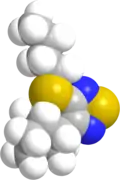Vedaclidine
Vedaclidine (INN,[1]:180 codenamed LY-297,802, NNC 11-1053) is an experimental analgesic drug which acts as a mixed agonist–antagonist at muscarinic acetylcholine receptors, being a potent and selective agonist for the M1 and M4 subtypes, yet an antagonist at the M2, M3 and M5 subtypes.[2][3] It is orally active and an effective analgesic over 3× the potency of morphine, with side effects such as salivation and tremor only occurring at many times the effective analgesic dose.[4][5][6] Human trials showed little potential for development of dependence or abuse,[7] and research is continuing into possible clinical application in the treatment of neuropathic pain and cancer pain relief.[8]
 | |
 | |
| Clinical data | |
|---|---|
| Other names | (S)-3-[4-(butylthio)-1,2,5-thiadiazol-3-yl]quinuclidine |
| ATC code |
|
| Identifiers | |
| |
| CAS Number | |
| PubChem CID | |
| ChemSpider | |
| UNII | |
| ChEMBL | |
| CompTox Dashboard (EPA) | |
| Chemical and physical data | |
| Formula | C13H21N3S2 |
| Molar mass | 283.45 g·mol−1 |
| 3D model (JSmol) | |
| |
| |
See also
References
- "International Nonproprietary Names for Pharmaceutical Substances (INN). Recommended International Nonproprietary Names (Rec. INN): List 38" (PDF). World Health Organization. 1997. Retrieved 18 November 2016.
- Shannon HE, Womer DE, Bymaster FP, Calligaro DO, DeLapp NC, Mitch CH, et al. (1997). "In vivo pharmacology of butylthio[2.2.2] (LY297802 / NNC11-1053), an orally acting antinociceptive muscarinic agonist". Life Sciences. 60 (13–14): 969–76. doi:10.1016/s0024-3205(97)00036-2. PMID 9121363.
- Womer DE, Shannon HE (September 2000). "Reversal of pertussis toxin-induced thermal allodynia by muscarinic cholinergic agonists in mice". Neuropharmacology. 39 (12): 2499–504. doi:10.1016/S0028-3908(00)00068-X. PMID 10974334. S2CID 31065787.
- Swedberg MD, Sheardown MJ, Sauerberg P, Olesen PH, Suzdak PD, Hansen KT, et al. (May 1997). "Butylthio[2.2.2] (NNC 11-1053/LY297802): an orally active muscarinic agonist analgesic". The Journal of Pharmacology and Experimental Therapeutics. 281 (2): 876–83. PMID 9152397.
- Shannon HE, Sheardown MJ, Bymaster FP, Calligaro DO, Delapp NW, Gidda J, et al. (May 1997). "Pharmacology of butylthio[2.2.2] (LY297802/NNC11-1053): a novel analgesic with mixed muscarinic receptor agonist and antagonist activity". The Journal of Pharmacology and Experimental Therapeutics. 281 (2): 884–94. PMID 9152398.
- Shannon HE, Jones CK, Li DL, Peters SC, Simmons RM, Iyengar S (September 2001). "Antihyperalgesic effects of the muscarinic receptor ligand vedaclidine in models involving central sensitization in rats". Pain. 93 (3): 221–7. doi:10.1016/S0304-3959(01)00319-0. PMID 11514081. S2CID 10256837.
- Petry NM, Bickel WK, Huddleston J, Tzanis E, Badger GJ (April 1998). "A comparison of subjective, psychomotor and physiological effects of a novel muscarinic analgesic, LY297802 tartrate, and oral morphine in occasional drug users". Drug and Alcohol Dependence. 50 (2): 129–36. doi:10.1016/S0376-8716(98)00026-X. PMID 9649964.
- Tata AM (June 2008). "Muscarinic acetylcholine receptors: new potential therapeutic targets in antinociception and in cancer therapy". Recent Patents on CNS Drug Discovery. 3 (2): 94–103. doi:10.2174/157488908784534621. PMID 18537768.
This article is issued from Wikipedia. The text is licensed under Creative Commons - Attribution - Sharealike. Additional terms may apply for the media files.